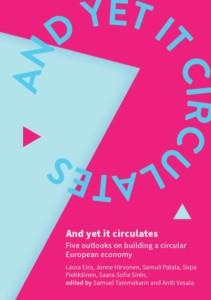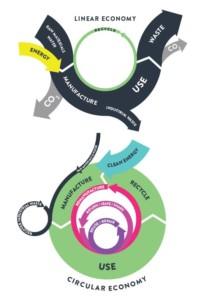And yet it circulates:
Five outlooks on building a circular European economy

According to the Ellen MacArthur Foundation, the circular economy, i.e., circularity, pursues three goals: planning out of waste and pollution, preservation of products and materials, and restoration of natural systems. The transition to a circular economy is not possible by only making recycling more efficient, as the products themselves must be made durable, repairable, upgradable and reusable. Only at the end of this life cycle is there the actual reuse of materials.
Currently, about 12% of the EU’s material flows remain circulating in cycle and reuse, with the Netherlands leading the way with a circularity rate of 24.5%. In Finland, the rate has fallen to only 7%, while in the world it is 8.6% on average. Why, despite all its advertised functionality, has the circular economy not yet taken off on a larger scale than this?
The longer the necessary decisions are postponed, the more expensive and riskier it will be to build a sustainable economy and society. This unavoidably builds pressure on the ruling parties that have built the current system, making radical and revolutionary solutions increasingly attractive. In particular, the years since the release of the last IPCC report have brought with them a number of grassroots movements increasingly hungry with their demands. These have especially been favoured by young people, which have lost confidence in the ability of the current economic and political system to solve the crisis at hand. As time passes, those who do not offer solutions will inevitably be seen as part of the problem.

”Kestävän talouden ja yhteiskunnan rakentaminen käy sitä kalliimmaksi ja riskialttiimmaksi mitä kauemmin välttämättömiä päätöksiä lykätään. Tämä paine myös välttämättä kohdistuu valtaapitäviin ja nykyjärjestelmän rakentaneisiin puolueisiin, jolloin radikaalit ja vallankumoukselliset ratkaisut voivat käydä yhä houkuttelevammaksi. Erityisesti vuodet IPCC-raportin jälkeen ovat tuoneet mukanaan joukon erityisesti nuorten suosimia ruohonjuuritason liikkeitä, jotka ovat lakanneet luottamasta nykyisen taloudellisen ja poliittisen järjestelmän kykyyn ratkaista käsillä olevat ongelmat, ja ovat samalla käyneet vaatimuksineen yhä nälkäisemmiksi. Ajan kuluessa ne, jotka eivät tarjoa ratkaisuja, tulevat väistämättä nähdyiksi osana ongelmaa.”
This publication presents five different points of view to what a circular economy is about. It covers decision-making on many levels; the role of cities in promoting circularity is also viewed, along with examples about industry, raw materials and logistics. The writers represent many backgrounds:
Sirpa Pietikäinen is currently a member of the European Parliament. She was the minister of environment of Finland in 1991-1995.
Saara-Sofia Sirén is a member of Finnish Parliament and also a member of the city council of the city of Turku.
Samuli Patala is an assistant professor in the Department of Management Studies of Aalto-University.
Laura Eiro is a lawyer who currently works as a program director in a Finnish network of smart and clean mobility.
Jonne Hirvonen (M.Sc. Tech) has been working at VTT Technical Research Centre of Finland since 2015. He specialises in concepts combining sustainable energy and data to circular economy and bioeconomy.
The conclusion and the summary in Finnish were written by Samuel Tammekann (soc.sc.student) who also acted as the editor for this book.
- Download the whole publication (pdf) from HERE (em. linkistä koko julkaisu englanninkielisenä)
- An abstract in English: DOWNLOAD
- Tiivistelmä suomeksi: LATAA
Lisätiedot (suomeksi) ja tiedustelut painetuista kappaleista:
vt. toiminnanjohtaja Antti Vesala
antti.vesala@toivoajatuspaja.fi